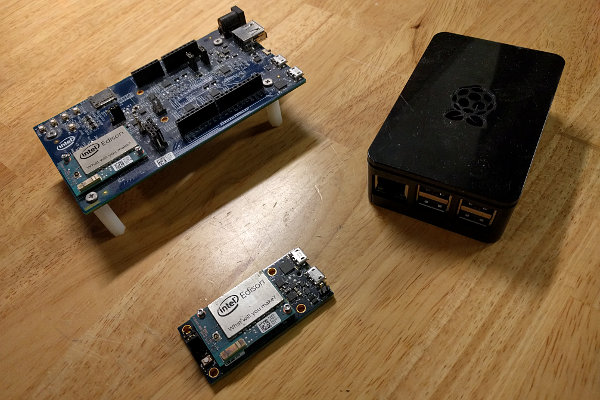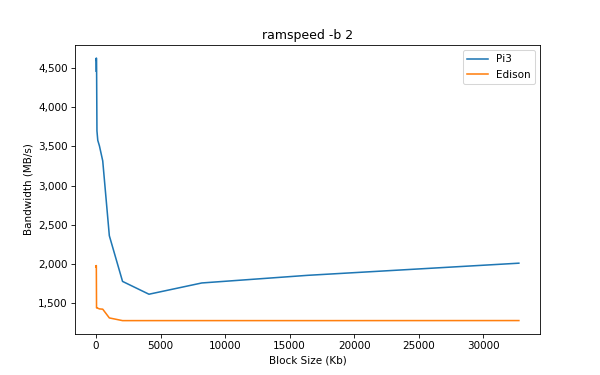Switching to Raspberry Pi
Back in October I mentioned in an ADS-B logging post that I had mixed feelings about using the Intel Edison for my embedded projects. This December I decided to make the jump and switch over to the Raspberry Pi. I don't have anything to say about the Pi that hasn't already been said- this post is just to provide me with some closure on the Edison.

Edison's Downfall
The Intel Edison had a lot going for it when it first came out. It featured a 32b x86 CPU, memory, flash, and wireless networking all on a tiny package for about $60. My first devkit had a socket for plugging in Arduino shields, which made it easy to use a lot of existing hardware and software. I bought a second Edison with a minimal breakout board so I could do low-power ADS-B monitoring. It looked like Intel was making smart moves to make a play in the emerging IoT market.
And then... nothing. While the Intel Message boards had a good amount of chatter on them, the only follow-up hardware relating to Edison was some Sparkfun gear and an expensive senor kit/book from Intel. In retrospect, there were a number if missteps on the hardware front. The Edison's micro i/o bus made it difficult for users to get at GPIO on their own. x86 compatibility was a wash because you usually had to recompile code to 32b in order to get it to run on the Edison. USB ports were limited. Worst of all, Intel never followed up with better hardware. Add Edison to the long list of Intel efforts where Intel was going to throw its weight around and take over a market but didn't (Hadoop, High-end GPUs, enterprise storage, smartphones... realsense and omnipath aren't looking so great these days either).
Edison vs Pi 3 Hardware
Back to the positive, though- I got a Raspberry Pi 3 kit for Christmas. The stats for the Pi are well known, but here's a summary of the differences between an Edison on a Breakout Board (BB) and the Pi 3:
Feature Edison(BB) Pi3 -------------- ---------- -------------- ISA 32b x86 64b ARM Cores 2 4 Clock 0.5GHz 1.2GHz Memory 1GB 1GB Internal Flash 4GB 0 Micro SD card no Yes Networking WiFi, BT Eth, WiFi, BT USB 1 4 GPIO 40pin 40pin IO Connector 70pin micro 40pin Video no HDMI Size 61x29mm 85x56mm Idle Power 0.7W 1.7W Cost $60 $40
Performance and Power
I did a few simple benchmarks to do a rough comparison between the boards. First I found and built a Monte Carlo program for computing Pi and let it run for 100M iterations. Using only a single core, the Edison and Pi3 took 52s and 19s respectively, making the Pi 2.7x faster. I started working on some multicore tests via OpenMP, but my Edison installation was missing libgomp and it didn't seem worth fixing. I also downloaded and ran ramspeed on the boards. The pi's caches seem to be 2.2x faster, while memory was 20% to 50% faster.

I hooked up the Pi3 to a few wall-socket power meters and took some preliminary readings. The meters said the Pi3 used about 1.7W when running headless with wireless (no usb, no hdmi). Launching 1-4 instances of the Pi program on the board raised the power to 2.2W, 2.7W, 3.2W, and 3.7W (thus 0.5W per active core). For comparison, the breakout board version of the Edison idles at 0.7W, and runs 1-2 instances of the Pi program at 0.9W and 1.1W (0.2W per active core). While the Pi3 uses 2.45x the power (per core) of the Edison, it's 2.7x faster and has a lot of I/O hardware ready for users. The Edison breakout board only has one mirco-usb port on it, which limits what you can do with it for projects. Upgrading to the Edison Arduino board to get more usb ports and more friendly pins eats more power. My empty Edison Arduino board used 2.4W while idle.
Other Perks
Another feature I really like about the Pi is that it boots off a removable microsd card. This feaure means I can use create multiple microsd os images and boot the hardware differently by plugging in a different disk (similar to the Amigas of my youth). It's also useful to be able to work on the os image on a desktop (installing packages on an embedded box always takes forever). Most importantly though, you don't have to worry about bricking your device if an install goes bad. Upgrading the on-device OS image for the Edison was nerve racking because it was difficult to repair the board if an install went wrong.
I didn't expect to use it, but the Pi's HDMI port has also been a source of fun. I hooked the HDMI up to the TV so I could do the inital network configuration. The display was faster and better looking than I expected, and I soon found myself taking a side trip into emulators via RetroPie. My family took an interest in the Pi when they realized we could plug multiple PS3 controllers into it and play Gauntlet. I wound up buying a Buffalo Classic USB Gamepad controller so we could get a more authentic-feeling SNES controller. At some point I'd like to revisit the emulation side of things and get the Amiga emulator configured right. I may also have to buy one of those X-Arcade Tankstick + Trackball controllers so I can show the kids the wonders of Centipede.

Possibilities
Now that I've started working with the Pi I'm kicking myself for not moving towards it earlier. The boards are cheap enough I can use them for one-off projects around the house, and there's plenty of info out there on how to do things with the hardware. That may mean I'll never do anything original with the Pi, but it's certainly more fun to get a project working than it is to spend a lot of time figuring out a work around for a proprietary board's under-documented hardware.
Update: Intel Quits IoT in June
Sure enough, Intel announced that they were killing off their IoT business and shutting down Edison, Joule, and Galileo June 20th. A sad consequence of this decision was that on July 5th they announced layoffs for 140 people (100 here in Santa Clara, 40 in Ireland). The sad thing is that it wasn't like the hardware wasn't selling- Intel's IoT area generated $721 million in revenue for Q1, which would be astounding for anyone but Intel.